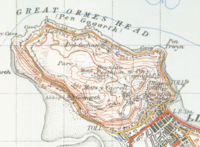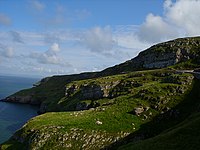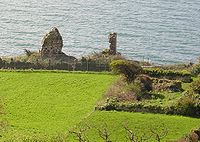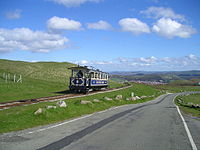Great Orme
| Great Orme | |
| Caernarfonshire | |
|---|---|
 Great Orme from Llandudno promenade | |
| Summit: | 679 feet SH767833 53°19’56"N, 3°51’11"W |
The Great Orme is a prominent limestone headland projecting from the north coast of Caernarfonshire into the Irish Sea. It is in the part of the county west of the River Conwy, joined to the mainland only by the low isthmus which is filled with the seaside resort town of Llandudno, whose holidaymakers are brought up to the Great Orme now by tramway and cable car. The northernmost part of the Great Orme forms the northernmost point of Caernarfonshire.
The headland is a hill on the sea, two miles long by a mile wide and rising at its summit to 679ft high.
On the Great Orme are extensive Bronze Age copper mines, discovered in the 1990s and which can be visited. The great opencast mine and the deep underground mines were carved out of the rock by Bronze Age men with no more than antlers, bones and stone hammers, great numbers of which have been found in excavations, which continue deep into the rock.
Thus the Great Orme can be enjoyed on several levels; a wild open space with interesting wildlife; as a breath of air off the sea away from the town; on the Marine Drive around its circumference; as a place of historical interest; or as an extension of Llandudno, its summit complex being barely different from the rather loud style of the town in summer.
Contents
Name
The headland is referred to as Cyngreawdr Fynydd in a poem by the 12th-century poet Gwalchmai ap Meilyr.[1]
The name "Orme" derives from the Old Norse word for sea serpent, which it is said to resemble.[2] It is echoed by the Little Orme, a smaller but very similar limestone headland, which is on the eastern side of Llandudno Bay in the parish of Llanrhos. The uttermost headland of the Grae Orme is Great Orme's Head.
The name of the Great Orme appears to be derived from the Old Norse word for sea serpent, similar to the English word worm having the same origin). Presumably Vikings from the sea believed that the Orme resembled the head of a sea serpent; this is a supposed etymology only though, for though the Norse raided in the area they do not appear to have settled it. There are other Norse names in the kingdom of Gwynedd (such as Point of Ayr), but etymology is an imprecise tool.
Until the coming of tourism in the 19th century (and the first tourists and developers came by sea), the name used for the wider peninsula as a whole was usually "Creuddyn" (the name of the mediæval cwmwd in the area) and Y Gogarth or Pen y Gogarth for the Great Orme itself, and the name Orme appears to have been used for the headland as seen from the sea. This is the case in the "Plan of the Bay & Harbour of Conway in Caernarvon Shire" by Lewis Morris and published in 1748, which map boldly shows the name "CREUDDYN" in the body of the peninsula and applies the name "Orme's Head" beyond the Great Orme headland at its north-westerly seaward point.[3]
Geology and natural history
The Great Orme is run as a nature reserve by the local council's countryside service, and is bound in a number of protective designations (including Special Area of Conservation, Heritage Coast, Country Park, and Site of Special Scientific Interest). It is home to a long-established herd of about two hundred feral Kashmir goats (acquired from Queen Victoria).[4] There are numerous paths for walking on the summit, including a section of the North Wales Path, a long-distance route. About half the Great Orme is in use as farmland, mostly for sheep grazing.
The geology of the Great Orme is limestone and the surface is particularly noted for the limestone pavements covering several headland areas. There are also rich seams of Dolomite-hosted copper ore.
The Great Orme has a very rich flora, including most notably the only known site of the critically endangered Wild Cotoneaster Cotoneaster cambricus, of which only six wild plants are known, all on the Great Orme.[5]
Many of the flowers growing in shallow lime-rich earth on the headland have developed from the alpine sub-Arctic species that developed following the last ice-age.
Spring and early summer flowers include Bloody Cranesbill, Thrift and Sea Campion, clinging to the sheer rock face, while Pyramidal Orchid, Common Rockrose and Wild Thyme carpet the grassland. The old mines and quarries also provide suitable habitat for species of plants including Spring Squill growing on the old copper workings.
The White Horehound (Marrubium vulgare), which is found growing on the western-most slopes of the Orme is said to have been used, and perhaps cultivated, by fourteenth-century monks, no doubt to make herbal remedies including cough mixtures. The rare Horehound Plume Moth (Pterophorus spilodactylus) lays her eggs amongst the silky leaves and its caterpillars rely for food solely upon this one plant.
The headland is the habitat of several endangered species of butterflies and moths, including the Silky Wave, the Silver-studded Blue (Plebejus argus subsp. caernesis) and the Grayling (Hipparchia semele thyone) These last two have adapted to the Great Orme by appearing earlier in the year to take advantage of the limestone flowers and grasses. Also they are smaller than in other parts of the country and are recognised as a definite subspecies.
The Great Orme is reported as the northernmost known habitat within Britain for several ‘southern’ species of spider notably: Segestria bavarica, Episinus truncatus, Micrargus laudatus, Drassyllus praeficus, Liocranum rupicola and Ozyptila scabricula.
The caves and abandoned mine workings are home to large colonies of the rare Horseshoe bat. This small flying mammal navigates the caves and tunnels by using echo location to obtain a mental picture of its surroundings. During the daytime, Horseshoe bats are found suspended from the roof of tunnels and caves, with their wings tightly wrapped around their bodies. Only at dusk do the bats leave the caves and mine shafts, to feed on beetles and moths.
The cliffs are host to colonies of seabirds (such as guillemots, kittiwakes, razorbills and even fulmars as well as gulls). The Great Orme is also home to many resident and migrant land birds including ravens, little Owls and peregrine falcons.
Below the cliffs, the rock-pools around the headland are a rich and varied habitat for aquatic plants and animals including barnacles, red beadlet anemones and hermit crabs.
Gogarth Manor
The mediæval parish of Llandudno comprised three townships, each established on the lower slopes of the Great Orme. The township of Y Gogarth at the south-western 'corner' of the Great Orme was latterly the smallest but it contained the palace of the Bishop of Bangor. The Manor of Gogarth (which included all three townships) had been bestowed on Anian, Bishop of Bangor by King Edward I in 1284 in recognition of services rendered to the crown, notably the baptism of the first English Prince of Wales, newly born at Caernarfon. The palace was burnt down by Owain Glyndŵr in 1400 and the ruins have mostly been washed away together with much of the township by coastal erosion in the Conwy Estuary.
The significant agricultural yet north facing township of Cyngreawdr includes the original parish church and rectory of St Tudno, a sixth or seventh century foundation. Following the Glyndŵr uprising, the villagers of the Creuddyn peninsula were harshly taxed and by 1507 they had nearly all fled their homes. Henceforth the cultivated land lay fallow and is now grazed by sheep and goats. Llandudno's Victorian cemetery, which is still in regular use, was laid out in 1859 adjacent to the 12th-century church of Saint Tudno where open-air services are held every Sunday Morning in summer. Nearby are several large ancient stones that have become shrouded in folklore and also an unexplained stone lined avenue called Hwylfa'r Ceirw leading towards Cilfin Ceirw (Precipice of Deer).
The third township was Yn Wyddfid clustered below the Iron Age hill fort of Pen y Dinas at the north eastern "corner" of the Great Orme. With the reopening of the copper mines from the 18th century onwards, this township grew considerably in size with the streets and cottages of the mining village laid out on the largely abandoned agricultural holdings.
The Great Orme Wells
Natural wells were greatly prized in limestone districts and the Great Orme was no exception. Water was required for copper mining purposes as well as for domestic and agricultural use. The following Great Orme wells are known and most still supply running water:
- Ffynnon Llygaid. Possibly one of the wells supplying the needs of the once populous Gogarth community before much of it was lost to coastal erosion.
- Ffynnon Gogarth. The main water source for Gogarth and in the later eighteenth and early nineteenth centuries the power source to operate the famous Tom and Gerry engine that though a long series of Brammock rods powered the mine water pumps at the Higher shaft near the summit above Pyllau.
- Ffynnon Powel. One of the water supplies together with ffynnon Tudno and ffynnon Rufeining serving the mediæval farming community of Cyngreawdr.
- Ffynnon Galchog. This well, near Mynydd Isaf, to the north of Pen Dinas, is a source of lime-rich water known for its petrifying qualities, it is one of two wells known to have been used in the washing of copper ores.
- Ffynnon Tudno. Situated beyond the road, near the north-east corner of St Tudno's Church, ffynnon Tudno was, together with ffynnon Rufeining, a principal source of water for the community settled round the church.
- Ffynnon Rufeining. Translated as "Roman Well", it takes its name from the tradition that Roman copper miners used its waters to wash the copper ores mined nearby.
- Ffynnon Llech. A spring of water located in Ogof Llech, a cave on the headland which is very difficult to access. It is claimed to have been used as a hermitage by Saint Tudno, a sixth-century monk of Bangor-is-y-Coed who established the first church here.
- Ffynnon Gaseg. Literally "Mare's well", this spring was revealed at the side of the road, about half way round and near the highest point, during the construction of the Marine Drive in the nineteenth century. It was ideally situated to refresh the horses on that five mile carriage drive round the base of the Great Orme.
The Copper Mines
The Great Orme Mines are possibly the most important copper mines of the Bronze Age yet discovered and excavated. Apparently abandoned around 600 BC, but with some evidence of Roman patronage, the mines were reopened in 1692 and continued to be worked until the end of the 19th century. It is possible that some of the copper from the mine was exported to Europe, even in the Bronze Age. In addition to the three main mining areas, there are many open-cast bell pit mines along the lines of the main geological faults.
In the 20th century the mines were once again reopened, and the Bronze Age mine workings are now a fee-paying attraction for the public to experience.
Views from the Summit
Due to its location the Great Orme commands extensive views particularly towards the east and north. On particularly clear days, the Isle of Man and the Lake District are visible on the horizon.
Tourism
A cabin-lift (built 1969) and the Great Orme Tramway, a vintage tram system (built 1902), convey visitors to the summit of the Great Orme, past one of only two artificial ski slopes in North Wales, complete with one of the longest toboggan runs in the United Kingdom.
Around the lower slopes of the Orme are landscaped gardens in the Happy Valley and terraces in the Haulfre Garden on the landward facing steeply sloping southern side. Walkways link the Haulfre Gardens with the western end of the Marine Drive.
The 'Marine Drive' toll road runs around the coastal perimeter of the Orme and leads to St. Tudno's Church, the award-winning Bronze Age Copper Mine and to the Great Orme Summit complex with car park. The toll road ticket also pays for the parking at the Summit Complex.
Among the summit complex attractions are a tourist shop, cafeteria, visitors' centre, a play area, a licensed hotel, cable car terminal and funicular railway/tram terminal.
On the northernmost point of the Orme there is the decommissioned Llandudno lighthouse which has been converted to a small bed & breakfast guest house with accommodation for eight guests. Nearby, on the Marine Drive, is the old established "Rest and be thankful" café with a large car park.
Military occupation
The Royal Artillery coast artillery school was transferred from Shoeburyness to the Great Orme in 1940 (and additionally a Practice Camp was established on the Little Orme in 1941) during the Second World War. Target practice was undertaken from the headland to both towed and anchored boats. Experimental work and training was also provided for radio direction finding. The foundations of some of the buildings and installations remain and can be seen from the western end of the Marine Drive. The site of the school was scheduled as an Ancient Monument in 2011 by CADW, the Welsh Government's Historic Monuments body. This was done in recognition of the site's significance in a UK and Welsh context. There was also a Chain Home Low radar station operated by the Royal Air Force at the hotel during Second World War.
Also of note was the Aerial Defence Research and Development Establishment (ADRDE) known as "X3" which was a 3-storey building erected in 1942. This seems to have been a secret radar experimental station situated above the artillery school. The road put in to serve it now serves a car park on the approximate site of the station. It was not demolished until 1956.
Outside links
- The Great Orme Exploration Society
- The Great Orme Tramway
- The Great Orme Summit Experience
- The Marine Drive
- Great Orme Mines
- Photos of Great Orme and surrounding area
- BBC Radio 4 programme on Bronze Age mining
References
- ↑ J. E. Caerwyn Williams (ed.), Gwaith Meilyr Brydydd a'i ddisgynyddion (University of Wales Press, 1994). 9.153n.
- ↑ "Great Orme copper mines". BBC Cymru Wales history website. BBC Cymru Wales. 25 August 2008. http://www.bbc.co.uk/wales/history/sites/themes/society/industry_copper.shtml. Retrieved 26 April 2013.
- ↑ Mary Aris, Historic Landscapes of the Great Orme page 32
- ↑ "The Great Orme Kashmiri Goats". llandudno.com. http://www.llandudno.com/goats.html. Retrieved 6 December 2010.
- ↑ Species Action Plan "Wild Cotoneaster (pdf file)". http://www.conwy.gov.uk/upload/public/attachments/48/WildCotoneasterv2.pdf.
- Ivor Wynne Jones. Llandudno Queen of Welsh Resorts Landmark, Ashbourne Derbyshire 2002 ISBN 1-84306-048-5 .
- Mary Aris. Historic Landscapes of the Great Orme. Carreg Gwalch, Llanrwst Wales, 1996 ISBN 0-86381-357-7 .
- Jim Roberts. Llandudno Past & Present, Sutton Publishing Ltd, Stroud, Gloucestershire 1992 ISBN 0-7509-2903-0 .
- Saxton's 1578 Map of Anglesey and Caernarvonshire labels the head of the peninsula Ormeshead Point.
- Philip C. Evans. "Llandudno Coast Artillery School" Llandudno Town Council 2011






